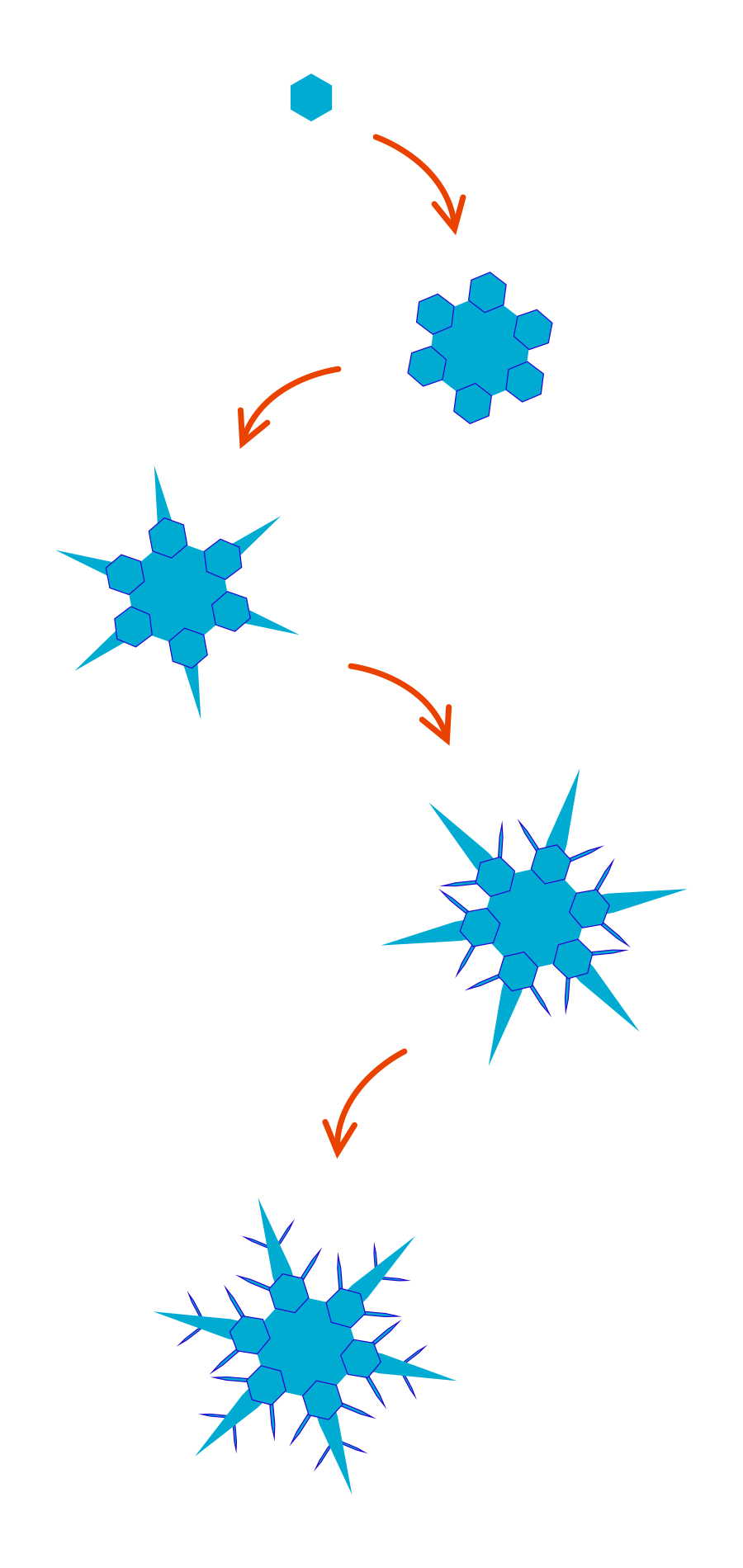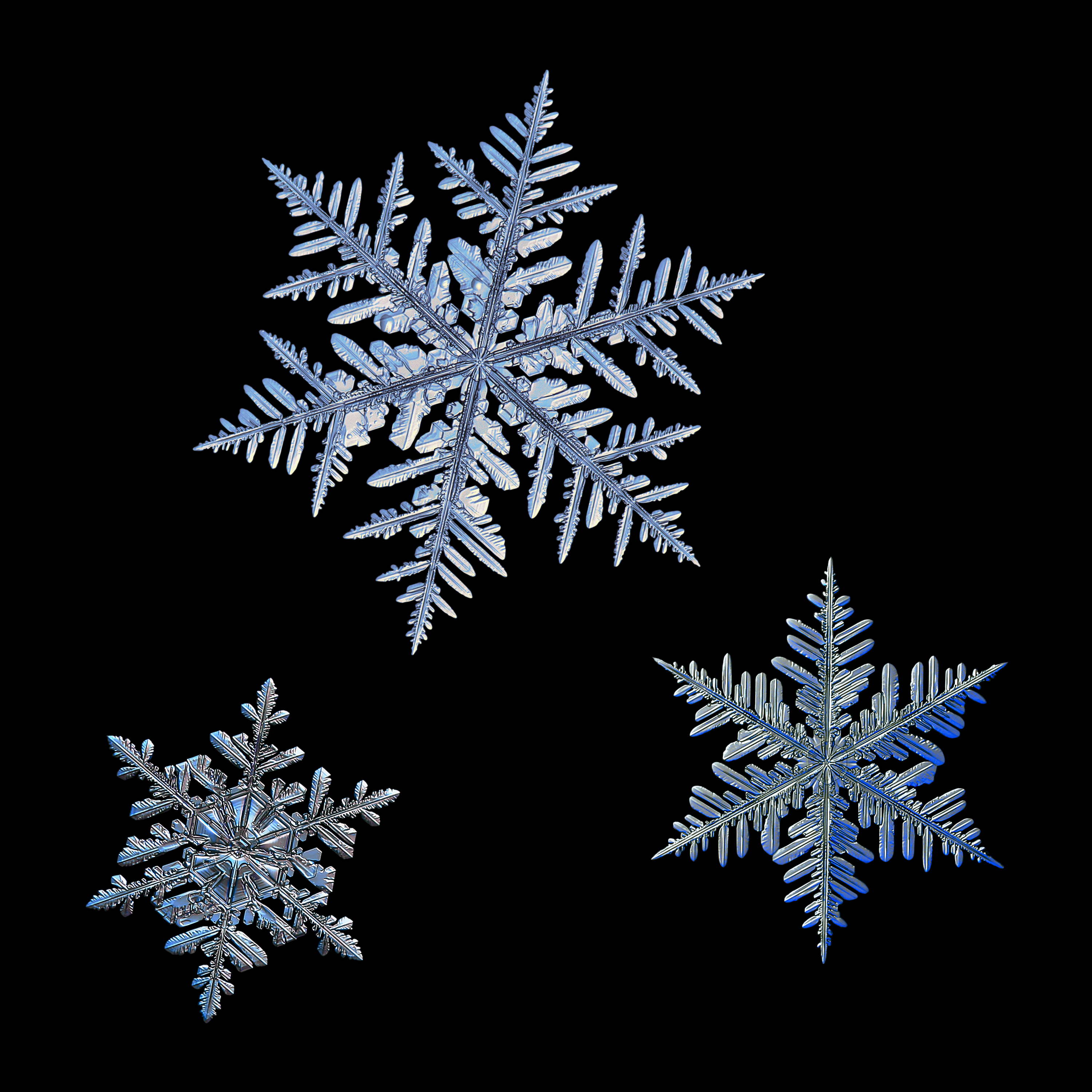This article first appeared in Issue 17 of our free digital magazine CURIOUS.
They say no two snowflakes are alike, but, when you think about it, how could anyone possibly know that? The truth is that you can’t, for reasons we’ll dive into later, but what we can know is that your chances of getting two identical snowflakes out in the wild are pretty much zero. Why? Because the process through which they form is so environmentally specific.
Snowflakes can be any old fleck that falls from a winter cloud, but when we talk about the individual structure that gets slapped all over festive decorations, we’re talking about snow crystals. These delicate crystals form in specific patterns depending on the temperature and are the result of water freezing from a gas (vapor) straight to a solid (ice) without first becoming liquid. When a waterdrop freezes, that makes what we call sleet.
The biggest snow crystals can take as long as 45 minutes to form, providing a big window for environmental conditions to change and shape their development. As it turns out, that classic Christmas “stellar” snowflake is just one of many forms these crystals can take, and within the minutiae exists near limitless variety.
The shape of snowflakes
A snowflake develops in stages, gradually increasing in diameter as it sprouts new branches, and the six-fold symmetry we see in snow crystals is due to the way water molecules are arranged within the lattice. The starting point is a three-dimensional hexagon, but this can be a long column or a flat plate. They typically develop slowly and symmetrically, but while maintaining a small size.

The process of snowflake formation.
Image credit: © IFLScience
However, six-sided isn’t the only shape on the cards.
“Most snowflakes are hexagonal, but sometimes they’re more triangular in shape, and on rare occasions, they’re almost perfect equilateral triangles,” Professor of Physics at Caltech Dr Kenneth Libbrecht told IFLScience. “They were first documented about 150 years ago and I’ve seen them outside many times. Why are they triangular? Part of the puzzle was that when you saw one, you were likely to see another, so they do cluster, and nobody had an explanation for that.”
Fortunately, Libbrecht was able to come up with one. Over two decades, he has been chipping away at the many mysteries surrounding the science behind snow crystals. A leading achievement was the establishment of a model that could explain why different temperatures give rise to different crystal shapes, something that was a mystery when he first set out.
“That was a puzzle it just seemed like somebody should solve. That’s an embarrassment to the scientific community that we don’t know how that works. I mean, this stuff falls out of the sky,” he continued.
Subscribe to our newsletter and get every issue of CURIOUS delivered to your inbox free each month.
Triangular snowflakes cluster because they require a very narrow window of environmental conditions to occur, namely being at -14°C (7°F) with the right humidity, creating just the right amount of instability to give rise to an alternative crystal shape. Libbrecht’s model pointed him towards these parameters, and when he tried them out in the lab – hey presto, triangular snowflakes.
That model hinged on the fact that the surface structure of ice depends on temperature, and it can undergo surface pre-melting where the top layer melts, changing the mobility of the molecules found here. While all falling snow crystals will experience surface pre-melting, they won’t go through it at the same time, as the microchanges in humidity and temperature they experience on the way down won’t be identical, as they don’t fall in an identical path at the same time.
A lot of variation, then. So, is it time for the big question?
Are no two snowflakes alike?
“I like to say it’s a bit of a Zen koan,” said Libbrecht – referring to the “paradoxical questions” Buddhist monks must address on their path to enlightenment. “Whether no two snowflakes are alike, it depends on exactly what you mean by alike. And what do you mean by a snowflake? In the lab, we make tiny, tiny little snowflakes the diameter of a human hair, and most of them are just simple hexagons, and they all look alike.”
“Those tiny crystals are outside too, and if you see them, they’ll look alike, but they’re awfully small. If you look at these big stellar crystals, then no, they’re very complex. And the complexity comes from the conditions during which they grow[…] You can estimate how many different ways there are to make a snowflake, and it’s just an astronomically large number.”

“The complexity comes from the conditions during which they grow.”
Image credit: Alexey Kljatov/Shutterstock.com
Libbrecht compares it to shuffling a deck of cards and calculating the chance you’d make the exact same 52-draw again. We can’t say for certain that it would never happen, but the chances are so incredibly slim as to almost be impossible.
The same is true of finding two wild “identical” snowflakes – which as Libbrecht points out in a moment, is probably the wrong word for it anyway. Besides the ridiculous odds of two crystals developing in the same way, your chances of catching them both outside? Now that’s definitely zero.
Can two snowflakes ever be the same?
It’s staggeringly unlikely that two snowflakes in the wild will fall in the exact same way, encountering the exact same conditions at the exact same time to wind up with the exact same structure. But what about in the lab? Well, Libbrecht did just that when he made what he calls “identical twins”.
“I call them identical twin snowflakes because identical is a bit of a loaded word,” he said. “Some people will interpret that as being identical down to the last molecule, and that’s never true. So, I like to say they’re a little like identical twin people: they are not exactly precisely alike, but they look far more alike than you would think.
“The way it’s done is I just drop a crystal onto a piece of glass and then blow warm air down on top of it and then I can change the growth conditions just by changing the temperature and the humidity[…] Because they’re fixed, that’s a little like having two crystals follow the exact same path through the atmosphere.”
“I can make them change and they will both change in the same way at the same time. It tells you that the growth is what we would call deterministic. It’s not extremely random. It’s mostly determined by the external conditions and if you can provide the same external conditions, then you will get very, very similar-looking snow crystals.”
And if you ever found that out in the wild? Well, it’d be a Christmas miracle.
How to ID snowflakes
Just like birdwatching, snow crystal enthusiasts observe snowflakes to see what crystalline structures they can ID. Want to try it? Here are some of Libbrecht’s top tips:
- Wear something warm with a dark sleeve – you need a backdrop for your snow crystal to land on.
- Take a magnifier – 5X should do it and cost less than $5.
- Know your snowflakes – just like how you need to know the species to see the birds, you’ve got to know your snow crystal before you can spot them in the wild. Libbrecht wrote what he calls a “field guide to snowflakes”, or you can find photographs and videos of different kinds on his website.
Then, all you need is some cold weather and a bit of patience.
CURIOUS magazine is a digital magazine from IFLScience featuring interviews, experts, deep dives, fun facts, news, book excerpts, and much more. Issue 17 is out now.
Source Link: Are No Two Snowflakes Really Alike, And If Not, Why Not?